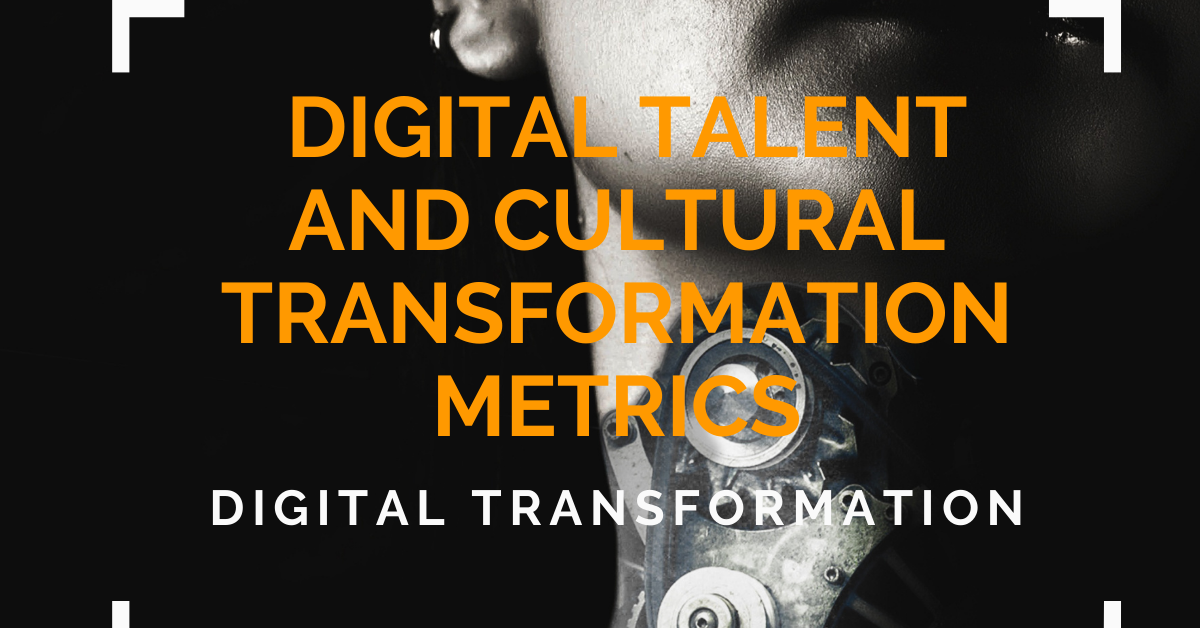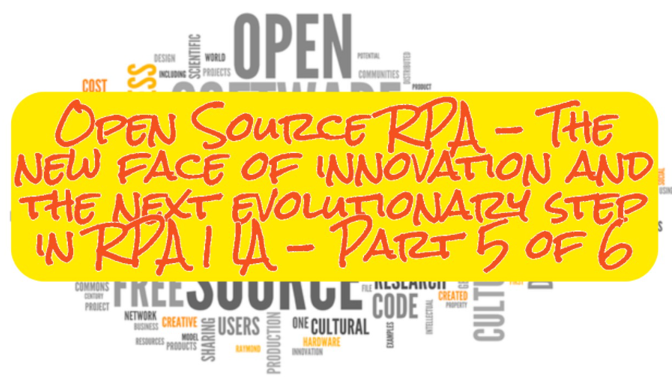Digital talent and cultural transformation metrics
It’s often said that culture trumps strategy. People, not just technology, transform organizations. So far we have outlined the Finance, Business, Operational, Platform and Process, Workforce, IT and Productivity Metrics that you should consider to judge the success of your automation program. Equally important, before an organization invests in an automation solution, is that they invest in the talent that they need to transform the organization.
Research by Capgemini and MIT Sloan has found that the so-called ‘digirati’ (i.e. the companies that understand the true value of digital transformation) are statistically significantly more profitable (i.e. on average by 26%) than their competitors. The markets also reward them with 12% higher valuations. Today, we look at what will help firms deliver a brighter, digital future i.e. digital talent and cultural transformation metrics.
Digital talent metrics
Customers, and many of your employees that were born digital, expect results quickly. They want to measure everything, are often connected to social media and contribute to the reducing gap between intent and delivery of service. Employee engagement and empowerment fuel this ecosystem of customers and your automation programs. This is one of the core principles that separates a successful vs a failed automation program.
Often when we both have looked at automation programs within organizations, we have found that the one driver most talked about i.e. cultural transformation – does not have a budget associated with it. Your teams need to see and experience the investment in people and cultural transformation, along with your investments in technology. And your investment in people needs to extend to training a digitally astute workforce. Where firms are heard and seen to invest in their teams, their teams are seen and heard to invest in the firm that is capable of driving the transformation.
1. Number of digital and automation certified staff )e.g. robotic process automation developers, controllers, or architects; cloud architects; hub managers). While certification is never a key determiner of success, it does show evidence of a degree of competency in a technology. Combing competency and capability should see an organization digitally transform successfully.
2. Hiring a team is one aspect, but ensuring they have the right mix of skills is critically important. Assess whether your automation team has these skills and if not how do you ensure they get them?
3. Number of high performing staff moved into digital leadership roles. Where jobs are recruited, and high performers are located, sends a huge signal to the business as to what is considered important within an organization and what is not. If divisions are made give up their best talent to digital roles and teams the rest of the organization will see this as a significant sign of intent. If high performers rewards are tied to digitally enabled results, then this will be a sure sign that digital transformation is to be taken seriously.
4. Top technical talent attracted, promoted and retained. The ability to attract, develop, promote and retain exceptional tech talent is arguably one of the most crucial drivers of long-term success for businesses in the digital age. If firms hire and retain great digital staff they will more likely succeed. If they don’t, they won’t.
5. Return on digital investments delivered by digitally augmented employees. Digital should not be done for the sake of doing digital and therefore CFOs and CEOs need to track their return on digital investments over time.
6. Talent mobility. This metric keeps track of the mobility of your talent internally or externally to the organization. One of the ways to measure talent mobility is to see who has moved into a digital transformation and/or automation role and what is their average assignment duration before moving on to another role.
Digital traction metrics
Change begins with recognizing change needs to happen. But delivering a change program does not guarantee a successful change program. Getting projects off the starting line does not guarantee that the firm will increase its revenue, profitability, market share or efficiency. Change required unlearning and is only successful if that change sticks and new habits formed remain after the initial change program has begun.
7. Number of processes developed by digitally augmented staff. Citizen Developers can be a thorny issue for some. However, there is no doubting the benefits that low-code and no-code development tools are bringing to organizations.
For example, twenty years ago firms would have had to hire a studio and expensive staff to produce a corporate or social media video (e.g. producers, editors, lighting, directing staff etc.). Today the marketing team in any business can produce high quality (i.e. 4k, 1080p) social media audio or website video content using low-code tools such as Canva, Streamyard, Veed and Audacity. These tools cost approx. $25 a month or are free.
As one example, organizations can measure how many video productions or processes are developed by citizen developer staff over time. Similarly, your process funnel for new automations is a good measure of how effective is your digital talent pool.
8. Time to market of digital apps. The speed at which ideas are translated into digital tools, applications or automated process that are used by customers or colleagues is critical to the success of a digitally enabled organization. Organizations should track how they are improving their digital delivery over time to ensure they are developing into agile, digital organisms that add value.
9. Transactions completed by robots versus humans. Often resource capacity plans only have people metrics. Overtime as digital workers are added to the workforce organizations need to differentiate between human and digital workers and show the numbers of transactions completed by both.
Beware of industry misnomers like ‘number of hours saved’ or ‘capacity added’ metrics that fall short of defining the tangible value to the organization. Instead consider ‘robot or bot utilization’, ‘ reduction in people time’ or what Shail likes to call ‘carbon vs silicon footprint’.
10. Percentage of online business orders completed by digital workers. Digital workers can complete transaction processing 24/7/ If digital workflows are built to enable end to end digital fulfilment, then overtime the % of transactions completed by digital workers should grow.
11. Percentage of annual budget spent on digital initiatives. Firms that spend only a small proportion of their business or technology budgets on digital initiatives are unlikely to benefit from digital never mind maximize their returns on their digital investment. The allocation of business or technology spend is a leading indicator that the firm can use to positioned itself to deliver digital value.
12. Successful chatbots or chatbot conversations. Digital interactions can be handled by chatbots. And chatbots can be employed in any part of the business e.g. HR chatbot to answer internal HR queries; customer service chatbot to answer customer queries and so on.
13. NDS – Net Digital Score. Leadership incentives are often tied to a Net Promoter Score. In your digital transformation journey, many are responsible for digital transformation but business leaders, in particular, need to be accountable.
An organization is considered digitally transformed, when their customers experience the transformation. In other words digital transformation should not be a self-declarative phenomenon. Consider a Net Digital Score (more on this coming soon) for your executives and align career and financial incentives to drive the right mindset. Often the right metrics can drive the cultural change outcomes desired.
Video: Dibya Basu, Digital Evangelist
Cultural transformation metrics
‘It not the strongest of the species that survive, nor the most intelligent, but the one most responsive to change’. Not often do you see Darwin quoted in a tech article, but this quote is apt in the age of automation and digital transformation. Without cultural change you can forget about a successful transformation efforts. If customer NPS and employee engagement are not rising then a business needs to revisit its digital transformation goals.
In talks Shail has often mentioned that the ‘Automation Emotion’ in your organization needs to be at the highest positive levels for your programs to succeed. Digital skills alone, don’t equal a mindset shift. Organization must put in place change-management initiatives that encourage the adoption of digital solutions and digital ways of working.
14. Employee Engagement. Measure your employee engagement often. Often done through an internal survey, engagement can also be determined by looking at talent mobility and the desire to move, teamwork levels, trust in leadership, etc. Rather than an annual survey, make employee engagement a continuous listening strategy. Cultural transformation is hard. Employee engagement is the pulse of your transformation and you want to measure it often.
15. Customer NPS. You are a digitally transformed organization when your customer says so. No doubt that following the introduction of digital channels, automation, your customer NPS should go up. Measure this often, at a minimum twice a year.
16. Time to build and implement digital applications. A measure of how quickly firms translate ideas into digital applications that can be used by business’s customer and colleagues.
Conclusion
Cultural transformation does not happen overnight. Willingness to change is a key ingredient to positive digital and cultural transformation. Equally important is the need to assign a budget, metrics and measures for assessing cultural transformation.
Creating an environment that willingly embraces automation will go a long way towards sustaining a successful automation program. This requires breaking down silos to promote a borderless organization, eliminating the fear of losing jobs while promoting the ‘what’s possible’ with automation, and encouraging ideas to build a robust automation pipeline.
A digitally transformed organization is such when customers experience the change. Its a journey, not to be done with seatbelts – dive in, hire/cultivate/reskill talent, measure what matters and most importantly create a positive Automation Emotion in your organization.
About the authors:


Shail is recognized as a thought leader, advisor and investor in RPA & Intelligent Automation. He writes extensively about digital transformation & automation and has served as a CMO & Chief Customer Officer of three leading automation firms, helping shape the industry. Shail founded and runs VOCAL (Voice of the Customer in the Automation Landscape) an independent, global automation customers only council, comprised of over 50 global brands. He is also an Advisor to multiple RPA/ AI firms. Follow Shail on LinkedIn and Twitter
#intelligentautomation #digitaltransformation #roboticprocessautomation #rpa #digitalfuture #digitalstrategy
Other articles: If you like this article then you may find these articles of use also.
- 32 real world experts outline the who, what and why when it comes to running an Intelligent Automation Centre of Expertise for FREE
- How to build a business case for Intelligent Automation and Robotic Process Automation
- 30 ways to build a pipeline of processes suitable for Robotic Process Automation (RPA) and Intelligent Automation (IA)
- The biggest lie told to RPA customers – 50 robots equals success
- If your RPA program is not making money then it has failed.
- RPA – Proof of Concept (POC) or Proof of Value (POV)? Who cares, just get going!
- 40 Essential Selection Criteria to Choose an RPA Platform – 5 part series
- The A-Z of Robotic Process Automation, Intelligent Automation and Digital Transformation
- How to scale successfully – you have 60 seconds to reply
- Can organizations implement RPA without having a digital transformation strategy – what would you have said?
- FREE training sites for Robotic Process Automation, Intelligent Automation, Data Analytics, Artificial Intelligence & Digital Training Sites
- 22 way to cut the cost of an automation program – 4 part series
If this could benefit someone else tag them and share this.
Free to reuse: We are a community of RPA, digital analytics, digital transformation and Intelligent Automation experts with years of real world experience. We have stories to tell and the scars to show for it. We share our collective wisdom for free to simply provide as much value as we can to you. Therefore, if you want to post this article on your LinkedIn page then please feel free to do so but recognise that I own the copywrite. The more information we share within the RPA community the more likely businesses are to succeed with this excellent technology.
Further Help: If I can help you in any way please do reach out.
Note: The views expressed above are our views and not those of my employer or the employers of the contributing experts.







Leave a Reply